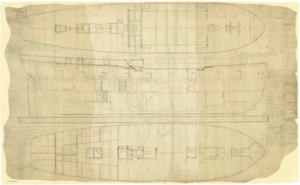HMS Hornet (1794) facts for kids

Hornet
|
|
Quick facts for kids History |
|
|---|---|
| Name | HMS Hornet |
| Ordered | 18 February 1793 |
| Builder | Marmaduke Stalkart, Rotherhithe |
| Laid down | April 1793 |
| Launched | 3 February 1794 |
| Completed | 14 May 1794 at Deptford Dockyard |
| Commissioned | January 1794 |
| Out of service | Sold 30 October 1817 |
| General characteristics | |
| Class and type | 16-gun Cormorant-class sloop |
| Tons burthen | 42855⁄94 (bm) |
| Length |
|
| Beam | 29 ft 8 in (9.0 m) |
| Depth of hold | 9 ft (2.74 m) |
| Propulsion | Sails |
| Sail plan | Sloop |
| Complement | 121 |
| Armament | 16 x 6-pounder guns + 12 x ½-pounder swivel guns |
HMS Hornet was a small but important warship in the British Royal Navy. She was a 'sloop-of-war' with 16 guns, built in 1794. Hornet was very active during the French Revolutionary Wars, which were big conflicts between Britain and France. Later, during the Napoleonic Wars, she became a hospital ship, helping sick and injured sailors. She was eventually sold in 1817.
Contents
Life of HMS Hornet: A Warship's Journey
Hornet began her service in March 1794. Her first commander was Christmas Paul. One of her early duties was to fire a salute to the King and Queen when they visited Portsmouth in June 1794.
Early Missions and Captures
After a short break, Hornet was back in action in 1795 under Lieutenant William Lukin. In 1796, Commander Robert Larkan took charge. Hornet worked with another ship, the Grand Falconer, to recapture a Portuguese ship called Diana. Later, Hornet captured a French transport ship named Emilie.
In 1798, Hornet and another ship, Daedalus, captured several vessels near Gorée, an island off the coast of Africa. These included:
- An American ship called Rebecca carrying goods like gunpowder.
- An American ship named President that the French had captured.
- A ship called Quaker that was carrying merchandise and 337 enslaved people.
- A sloop named Ocean that belonged to the Sierra Leone Company.
- A French schooner called Prosperité.
- A French armed ship named Bell, which the British destroyed.
Adventures in the West Indies
After some repairs, Hornet sailed to the West Indies in 1799. In 1800, she joined a convoy, which is a group of ships traveling together for safety.
While in Guadeloupe, a boat from Hornet tried to force some men to join the navy from a ship called New Ceres. The crew of New Ceres fought back, and Hornet's second lieutenant was killed.
Hornet continued to be active, capturing two French privateer ships: Femme Divorcee and Mahomet. Privateers were private ships allowed by their government to attack enemy ships.
In January 1801, Hornet and other British ships tried to capture French ships near Vieux-Fort, Guadeloupe. They managed to take one French vessel. A few days later, boats from Hornet and Daphne captured a French schooner named Eclair from under the protection of shore batteries. The British later used Eclair as their own warship.
Capturing Islands and New Commanders
In March 1801, Hornet helped in a successful attack led by John Thomas Duckworth to capture the islands of St. Bartholomew and St. Martin. Hornet stayed at St. Martin to secure the island.
In August 1802, Lieutenant Robert Tucker took command of Hornet, followed by Commander Peter Hunt the next month.
In June 1803, Hornet was part of a squadron that captured Saint Lucia and Tobago. In September, Hornet captured a Dutch ship carrying 410 enslaved people. Later that month, Hornet helped capture the Dutch colonies of Demerara and Essequibo. Commander Hunt was promoted for his success.
In 1804, Commander John Lawrence became Hornet's new commander.
HMS Hornet: A Hospital Ship
After her active service, Hornet was turned into a hospital ship. This meant she was used to care for sick and injured soldiers and sailors. She was fitted out for this new role between 1804 and 1805. In June 1805, she started her new job in the Isles of Scilly under Lieutenant Charles Williams. Sadly, Charles's brother, Henry Williams, drowned in 1810 after falling overboard. He was buried in the Tresco Abbey Gardens.
The End of Hornet's Service
Hornet finished her service as a hospital ship in May 1811 and was stored at Plymouth Dockyard. She was offered for sale in January 1817. Finally, Hornet was sold on 30 October 1817 for £920.
Notable People on HMS Hornet
From November 1795 to September 1797, Richard Spencer served as a midshipman on Hornet. He later became a hero during the Napoleonic Wars and was an important pioneer in Australia.


